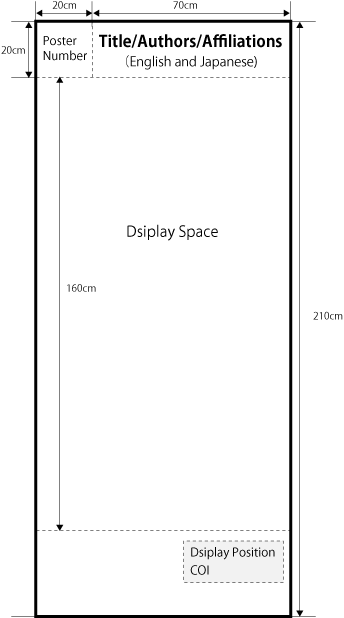Information for Session Chairpersons
- Chairpersons are requested to arrive at the venue for their session 15 minutes in advance and to make their presence known to the staff in the presentation room.
- Please be punctual the timetable for presentations and Q&A sessions to ensure the smooth running of the Meeting.
About COI
At all of the sessions of The 58th Annual Meeting of the Japanese Society for Neurochemistry, please be sure to show slides(or posters)related to the stipulated COI when making presentations. Oral explanations are not necessary at the time of presentation. Please read the meeting website information about downloading the stipulated slides and how to use them.
People presenting specified subjects and Oral Session
*Please read“ Criteria for COI applicability” below for applicability criteria.
Not applicable
On the title slide, please make a box that includes an explanation that COI are not applicable.

Applicable
On the first slide, please show the Society’s designated COI slide.

People presenting posters
*Please read“ Criteria for COI applicability” below for applicability criteria.
Not applicable
At the bottom of the poster, please make a box that includes the statement“ Presenter COI not applicable.”
Applicable
At the bottom of the poster, please make a box that states the applicable items(. This can be either in the form of a table or in text.)

Criteria for COI applicability
- Things that require a disclosure statement are those relating to presentations within the one-year period.
For each of the items that should be disclosed, the amounts of money that require self-reporting are stipulated as follows.
In the event that any of the following items applicable, they are to be deemed “applicable” and the relevant company name and the relevant people’s names are to be indicated.- Presenting authors who are officers or advisors of companies or for-profit organizations shall report annual remuneration from a single company or organization of 1 million yen or more.
- Presenting authors shall report stock ownership in cases where profit(the sum of dividends and profit on sale)from shares of a single company during a one-year period is 1,000,000 yen or more or where they own 5% or more of the total shares.
- Presenting authors shall report patent royalties or licensing fees from companies or for-profit organizations in cases where royalties or licensing fees for a single patent are 1,000,000 yen or more per year.
- Presenting authors shall report the regular income which receive from other than current expenses at worksite.
- Presenting authors shall report research funding from companies or for-profit organizations provide in cases where the total amount of research funding paid for a single instance of clinical research is 2,000,000 yen or more. Presenting authors shall report scholarships(grants)in cases where the total annual amount paid to a single research leader from a single company or organization is 2,000,000 yen or more.
- Presenting authors shall report honoraria(such as lecture fees)paid by a company or forprofit organization as compensation for the time or labor of a researcher engaged for conference attendance(presentation)in cases where annual honoraria from a single company or organization are 500,000 yen or more.
- Presenting authors shall report matters which may be pointed out from a third party.
ex. Regarding the furnishing of other travel, gifts, etc. not directly related to the research, the total amount received from one business, organization or group in one year in 50,000 yen or more.
Animal Experiments
Regarding animal experiments, it must be followed guidelines shown below.
“Law of Humane Treatment and Management of Animals”,
“Basic Rule for Keeping and Managing Animals”,
“Fundamental Guidelines for Proper Conduct of Animal Experiment and Related Activities in
Academic Research Institutions”,
“Guidelines for Proper Conduct of Animal Experiments”,
“Guidelines for scarification of animal”
Other laws and ordinances
Rules and regulations based on authors’ institution.
Furthermore, it must be based on 3R( Replacement, Reduction, and Refinement).
The 3R are;
- Replacement: preferred use of non-animal methods over animal methods whenever it is possible to achieve the same scientific aims.
- Reduction: use of methods that enable researchers to obtain comparable levels of information from fewer animals, or to obtain more information from the same number of animals.
- Refinement: use of methods that alleviate or minimize potential pain, suffering or distress, and enhance animal welfare for the animals used.
Those who meet the requirements, please be sure to stipulate that the authors follow these guideline.
Information for Speakers in Symposia, and Speakers in Oral Sessions
Languages for Presentations
- With some exceptions, general oral presentations will also in principle be given in English.
Timing of Presentations
- Please comply with the chairperson’s directions during symposia.
- The time allowed for Oral Sessions and JSN Oral Educational Session for Young Investigators presentations is 15 minutes for the presentation and 5 minutes for Q&A(. Please comply with the chairperson’s directions.)
Making Presentation
- Please bring your computer to the PC Preview Desk(in the foyer, 1F Sonic City Main hall, lobby, 4F floor Sonic City Bldg.)at least 60 minutes before your presentation to check the output.
- Please give your own laptop to the Computer Operator Desk(on the left-hand side facing forwards inside the presentation room)at least 30 minutes before your presentation.
- During your presentation, you can operate your computer by yourself using the monitor and remote mouse on the podium.
- There is a time indicator on top of the podium. Your cooperation in finishing your presentation within the allotted time is requested.
- During presentation:green light.
- One minute left to termination:yellow light.
- Termination:red light. - After the end of your presentation, please reclaim your computer from the Computer Operator Desk.
Presentation Instrument
- Presentations are restricted to computer presentations using your own personal computer in the Meeting.
- Please use a computer running Windows8, 7, Windows Vista, or Macintosh OS X or later, and fitted with an external monitor output terminal.
- If you are using a Sony VAIO, Macintosh, or other type of computer with a special-format monitor output terminal, please bring a D-sub15 pin conversion adaptor with you.

- Be sure to bring an AC adaptor to the presentation venue in case your computer’s battery runs out.
- Please adjust your computer settings so it does not revert to screensaver or energy-saving mode during your presentation.
- If your presentation data includes links to stills, moving images, graphs, or similar data, please be sure to save these files and check their operation in advance.
- Audio cannot be used during presentations. Should you require audio, please contact the Convention Secretariat in advance.
Information for Poster Presenters
- Please make your poster to fit the space within the display panel. The panel size is shown in the figure on the below.(Height:210cm、Width:90cm)

- Please prepare the title of your presentation, institution and presenter’s names them at the top of the space for putting up your poster.
- Posters will be changed every day.
September 11(Fri)
Poster Installation: 8:30 – 10:00
Poster Viewing: 10:00 – 18:00
Poster Discussion:
Odd Number 11:00 – 12:00
Even Number 13:00 – 14:00
Poster Removal: 18:00 – 18:50September 12(Sat)
Poster Installation: 8:30 – 10:00
Poster Viewing: 10:00 – 18:30
Poster Discussion:
Odd Number 11:00 – 12:00
Even Number 13:30 – 14:30
Poster Removal: 18:30 – 19:00September 13(Sun)
Poster Installation: 8:30 – 10:00
Poster Viewing: 10:00 – 18:00
Poster Discussion:
Odd Number 11:00 – 12:00
Even Number 13:00 – 14:00
Poster Removal: 18:00 – 18:50 - Please display your own poster in the position indicated by your presentation number within the stated time for putting it up. Presentation numbers are already indicated on display panels. Please check your presentation number and be careful to put up your poster on the correct panel.
- Tacks for putting up posters are available from the Secretariat. Please do not use glue or cellophane tape.
- Please attach the ribbon given at the poster reception desk on your chest, stand in front of your poster panel during the explanatory and Q&A sessions listed below, and respond to participants’ questions(there will be no chairperson to move the sessions along).
- Please help by taking your own poster down. Posters still displayed after the removal time has passed will be disposed of by the Secretariat the following day.
Request Concerning Use of Color in Presentation Materials
Around 5% of Japanese men(3 million people)and 8% of Caucasian men have a specific type of vision that makes it difficult to distinguish between colors in a particular range, including red and green. In light of this, you are requested to take the following points into account when preparing presentation materials.
- Images of two-color staining or DNA chips should be displayed in green and magenta, not red and green.
- Three or more stains should not be displayed only as composites with all three colors, but also with the two most important colors alone shown in green and magenta(. Alternatively, images of each channel can be displayed separately.)
- In graphs and explanatory figures, it is extremely difficult to match colors shown in two separate places. For this reason, do not use only color-coded descriptions or legends for different items, but write them directly into figures.
Do not differentiate between items by using different colors, but rather with different types of line, shapes/symbol, or types of hatching. - On a dark background, use white, yellow, or orange lettering as far as possible.
For further information, see http://www.nig.ac.jp/color/.

